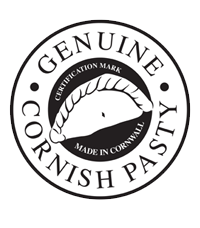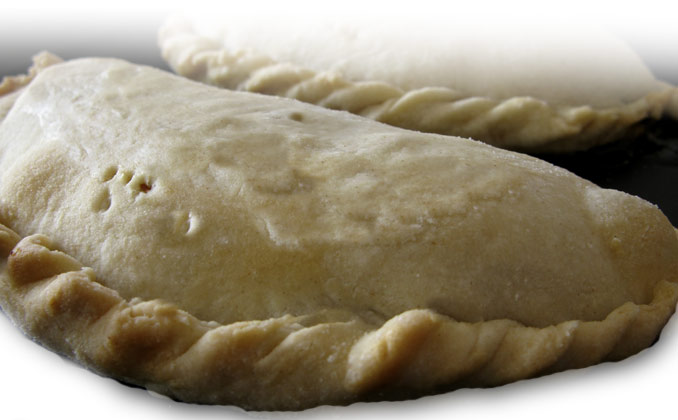 THE
CORNISH PASTY
THE
CORNISH PASTY
It was once said that the Devil would never dare to cross the River Tamar into Cornwall for fear of ending up as a filling in a Cornish Pasty.
For centuries the Cornish have been filling their famous pasties with almost any ingredients that you would care to think of.
The traditional filling is, of course, beef and potato, usually with slices of onion and swede mixed in as well, but the humble pasty can also be found in a number of other guises.

|
|
|
|
|
ads
|
Popular fillings down the years have included Egg and Bacon, Rabbit, Apples, Figs, Jam, and Egg and Currants. There is virtually no limit to what tasty filling you might find when you take a first bite into that delicious crunchy pastry!
Surprisingly, however, in a region where the sea plays such an important role in everyday life, fish has never been regarded as an appropriate pasty filling. In fact, the more superstitious among Cornish fishermen will refuse to take a pasty on board their boat when they set out to sea, in the belief that it will bring them bad luck.
The pasty originally evolved to meet the needs of tin mining, that other great, but now sadly declined, Cornish industry. A hearty meal wrapped in a pastry casing made for a very practical lunch (or "croust" , as they used to call it ) down in the dark and damp tunnels of the mine. Some mines even built huge ovens on the surface to keep the miner's pasties hot until it was time to eat.
Tradition has it that the original pasties contained meat and vegetables in one end and jam or fruit in the other end, in order to give the hard-working men 'two courses'. Cornish housewives also marked their husband's initials on the left-hand side of the pastry casing, in order to avoid confusion at lunchtime. This was particularly useful when a miner wished to save a 'corner' of his pasty until later, or if he wanted to leave a corner for one of the 'Knockers'. The Knockers were the mischievous 'little people' of the mines, who were believed by the miners to cause all manner of misfortune, unless they were placated with a small amount of food, after which they could prove to be a source of good luck.
Today there is still a great deal of debate among pasty-makers about exactly how a genuine pasty should be made. Many will tell you that a pasty can only be made with short pastry, while others will advocate rough puff as the ideal pastry. Some will claim that the ingredients must be mixed up inside the pastry, while others will swear that the fillings should be laid out in a particular order before the pasty is sealed. The issue that invites the most controversy involves the famous 'crimp', the wavy seam that holds the whole pasty together. Should the pasty be sealed across the top, or at the side?
History suggests that the crimp should be formed at the side, because the pasty has always been eaten by hand, and the side crimp is the most convenient way of holding onto your lunch while you take a big bite. Others may beg to differ! There are, fortunately, some facts that can be agreed upon by all pasty-makers. The meat should be chopped, the vegetables should always be sliced, and the ingredients must never be cooked before they are wrapped in the pastry. Each pasty must be baked completely from raw. It is this fact that makes the Cornish Pasty unique amongst similar foods from around the world.
Nobody knows for certain the true origins of the pasty, although it can be traced at least as far back as the middle ages. It is believed that Henry VIII's Queen, Jane Seymour, enjoyed a tasty pasty on several occasions. Over the years the pasty has spread across the country and around the world. Variations can be found in counties such as Yorkshire, Lancashire, and Cumberland, although it has been suggested that Cornish miners introduced the pasty to these places when they left Cornwall and moved up-country in search of work. Cornish emigrants also introduced the pasty onto the American continent. They are popular in parts of the United States, as well as in Argentina and Mexico.
Depending on where you go, pasties come in all sorts of shapes and sizes. Until recently, a group of Young Farmers in Cornwall held the record for making the largest pasty known to man. The pasty, which was baked in 1985, took seven hours to make, and measured over 32 feet in length! Amazingly, their record was believed to be beaten in May 1999, when bakers in Falmouth made their own giant pasty during the town's first ever Pasty Festival.
The pasty is, and always shall be associated with Cornwall. It holds a special place in Cornish culture and in the hearts of the Cornish people. For many people the pasty is the greatest symbol of Cornwall. When the Cornish Rugby team plays an important match, a giant Cornish pasty is symbolically hoisted over the bar before the start of the game. It is a tradition that dates back to 1908, and the original giant pasty is still used to this day.
While many inhabitants of Cornwall still like to bake their own, the pasty has risen to become big business in shops and supermarkets throughout the country. Nowadays, you can even dial-a-pasty straight to your door!
Any Cornish man or woman will tell you, however, that a true Cornish pasty can only be homebaked in the traditional way, and you will only experience the mouth-watering taste of a true Cornish pasty if you pay a visit to the county where it was created.
 |
|
Promoting
your business on Cornwall Online |
|
Cornwall
Online is a trading name of ITS WEB DESIGN - COL DIRECT
Cornwall Online Website by ITS WEB DESIGN - COL DIRECT. Tel 01579 557343 |